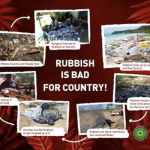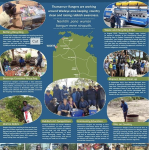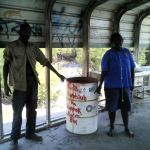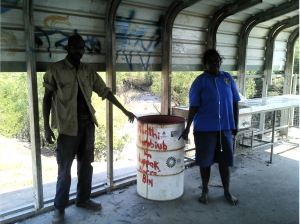Thamarrurr Rangers Wadeye – ‘No Rubbish On Country’ SRP
Source Reduction Plan (SRP) Overview
Name of SRP
Partners Delivering the SRP
- Tangaroa Blue Foundation – created, delivered training in Wadeye and supported the SRP
- Thamarrurr Rangers – Delivered SRP
- Thamarrurr Development Corporation (TDC) – funded Tangaroa Blue to provide training for the use of AMDI and to support the SRP’s
- Wadeye Women’s Centre – engagement and involvement in community events
- West Daly Regional Council Wadeye Office –Funding provided for the Thammarrurr Rangers ongoing ground-work
- Kardu Yek Diminin – Traditional owners of the land
Location
Wadeye Community – Northern Territory, 0822
Photo 1
Evidence of the issue

Photo 2
Evidence of SRP resources

Photo 3
Evidence of positive outcomes

Overall Goals & Background
Targeted Debris
General Litter – Litter generated within the Wadeye community, at the campsites, and marine debris along Wadeye Beach and surrounding areas.
Why is the SRP needed?
In remote Indigenous communities, the issue of waste, which is a relatively recent problem, has emerged. Traditionally, waste materials from food, clothing, tools, and other items were sourced from the land and returned to it through recycling, such as seeds from fruits, animal bones and skins, and timber offcuts. However, in modern times, these communities face a significant challenge with a vast amount of non-recyclable packaging and waste materials, such as plastics and metals. This presents a novel dilemma of waste management in areas where the concept of “rubbish” is relatively unfamiliar, and its environmental impacts have not been adequately addressed.
The lack of infrastructure in these remote regions often leads to littering and the uncontrolled disposal of waste into the environment. It is crucial to not only determine the required infrastructure but also to carefully choose its placement. In some cases, conducting trials to identify the best location and the appropriate amount and type of infrastructure needed to minimise littering.
Logistics
Timeline and Project Goals
Measuring Success
The primary objective of this SRP was to actively involve the community and explore methods to increase the availability of bins within and near campsite areas and also ways to recycle and reduce amounts going to landfill.
This involved repurposing 20 old fuel drums as bins signed with “Nanthi Rubbish ka Dupak Ngarra Bin” (Put Your Rubbish in the Bin), aiming to promote responsible waste disposal for campsite visitors and to discard any marine debris gathered from the nearby beaches.
Furthermore, partnerships between Tangaroa Blue, the Thamarrurr Development Corporation, and Rangers supported the community in finding creative and innovative ways to develop and establish recycling services for Wadeye. These initiatives involved recycling cans and bottles through the containers-for-change program, as well as CDs, car batteries, scrap metal, and various other items that a local freight company, Murin, transports to Darwin for free and the recycling company refunds the community. As Wadeye gains monetary returns, this benefits the community economically but also provides a strong incentive for recycling efforts.
Since 2014, the Thamarrurr Rangers have set up 11 marine debris monitoring sites across their vast 250 km coastline by foot, car, and boat and then reported their collections to the Australian Marine Debris Initiative (AMDI) Database as part of their on-ground work. As the bins plan to remain in position, we can measure the effectiveness by monitoring the frequency that the bins need to be emptied and reductions of litter and debris being collected from those areas within clean-ups.
Tangaroa Blue Foundation held a community meeting with elders, rangers, representatives from the Women’s Centre, Council and the School to discuss the data findings and to explore potential plans for future source reductions. The up-cycling of old fuel drums into bins for the campsites and barge landing, an art competition using litter/marine debris as material and inspiration for their art pieces and more focus on recycling.
Quote from Tangaroa Blue article:
“In less than 3 months since the recycling program started, over 25,000 items of rubbish have been brought down to the Ranger Base by ~80 Community members. People are noticing that Wadeye is looking cleaner, as most of these items are rubbish lying around the Community. The local freight company, Murin, supports the Community by taking this recycling back to Darwin for free, and a Recycling Company in Darwin then refunds the Community. The Rangers have started with a small and simple recycling program, but have been very encouraged by the Community response and will continue to develop opportunities for recycling and reducing waste at Wadeye.”
Data Collection & Reporting
Audit & Reporting –
Thamarrurr Rangers work with the community to engage in campsite and beach clean-ups, whereby the debris is collected, weighed and sorted into the appropriate categories for the AMDI database and then uploaded by the Rangers.
Results and Reflections
Positive Outcomes
The most rewarding success of this SRP was the strengthening of community engagement and involvement, as the Indigenous Rangers continue to engage and promote positive land and sea management plans.
The bins remain within the campsites and near the barge landing, alongside informative and encouraging messaging on the importance of correct disposal and the impacts on the marine environment.
Each year at the Wadeye Festival entries for the art competition continue to rise and it is a creative way to encourage and educate the younger generation on the importance of preventing marine debris.
The Thamarrurr Rangers were invited to present a seminar at the Australasian Waste and Recycling Expo in Sydney 10-11 August 2016. Maureen Simon and Rosaline Melpi were nominated to go to Sydney because of their work in establishing a recycling service at Wadeye. They were supported by Heidi Taylor from Tangaroa Blue Foundation, to present a seminar on ‘Waste Management Learnings from Indigenous Australia’. Maureen and Rosaline presented a movie they had made about the waste problem at Wadeye and some of the ways they are addressing this problem. In addition, they answered numerous questions from their audience who were interested to hear about waste management solutions in a remote Indigenous community.
Funding
Challenges & Improvements
Future Opportunities
Following the successful community meeting, the rangers will continue their clean-ups and regular monitoring as part of their on-ground work providing invaluable data sets to the AMDI Database.
Further community engagement was received for the art competition using litter/marine debris as material and inspiration for their art pieces each year.
Recently the Thamarrurr Rangers assisted the beach clean-ups at Mapoon which was a great opportunity to share knowledge and ideas across remote communities.






